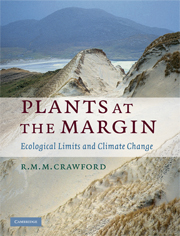Book contents
- Frontmatter
- Contents
- Preface
- Acknowledgements
- PART I THE NATURE OF MARGINAL AREAS
- PART II PLANT FUNCTION IN MARGINAL AREAS
- PART III MARGINAL HABITATS – SELECTED CASE HISTORIES
- 5 Arctic and subarctic treelines and the tundra–taiga interface
- 6 Plant survival in a warmer Arctic
- 7 Land plants at coastal margins
- 8 Survival at the water's edge
- 9 Woody plants at the margin
- 10 Plants at high altitudes
- 11 Man at the margins
- 12 Summary and conclusions
- References
- Author index
- Species index
- Subject index
12 - Summary and conclusions
Published online by Cambridge University Press: 06 July 2010
- Frontmatter
- Contents
- Preface
- Acknowledgements
- PART I THE NATURE OF MARGINAL AREAS
- PART II PLANT FUNCTION IN MARGINAL AREAS
- PART III MARGINAL HABITATS – SELECTED CASE HISTORIES
- 5 Arctic and subarctic treelines and the tundra–taiga interface
- 6 Plant survival in a warmer Arctic
- 7 Land plants at coastal margins
- 8 Survival at the water's edge
- 9 Woody plants at the margin
- 10 Plants at high altitudes
- 11 Man at the margins
- 12 Summary and conclusions
- References
- Author index
- Species index
- Subject index
Summary
SIGNS OF CHANGE
We live in times of change and the impact of climatic warming can already be seen in many marginal areas. Effects that appear to be directly attributable to climate change are most noticeable in polar and alpine regions with the retreat of glaciers and snow and ice cover regions (Fig. 12.1). Coastal erosion as a result of rising sea levels is also having a noticeable impact. Archaeological rescue excavations of ancient coastal settlement sites exposed by erosion are now numerous. Several Scottish coastal golf courses have had to be redesigned as sections have been totally removed by the advancing sea. A coastal Scottish National Nature Reserve (Tentsmuir) that had been growing steadily seawards for centuries is now in places retreating rapidly by as much as 200 m depth of dunes over the last 20 years, returning sections of the coastline to where they were in the 1920s (Fig. 12.2).
More positive changes include an increase in the number of plant species to be found on the summits of European mountains (see Section 10.7), and an earlier flowering of the vernal flora with an extension of the growing season into the autumn. Northern agriculture is also profiting from the passing of the Little Ice Age in both crop production and length of the grazing season. However, in many parts of the world deleterious changes are taking place which are being aggravated by increasing human disturbance.
- Type
- Chapter
- Information
- Plants at the MarginEcological Limits and Climate Change, pp. 419 - 432Publisher: Cambridge University PressPrint publication year: 2008



